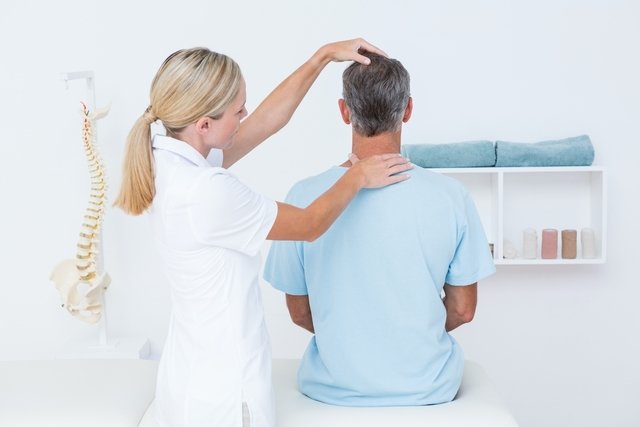Cervical stenosis is characterized by wear and tear of the cartilage of the intervertebral discs in the cervical spine. These are located in the neck and can become less elastic due to water and nutrient loss of water. This condition is associated with symptoms such as neck pain, burning in the neck, or tingling in the arms.
Cervical stenosis is a type of osteoarthritis, and is more common in older adults. It is caused by wear and tear of the joints that occurs with normal aging, but it can also occur do to repetitive movement injuries or direct trauma.
The treatment of cervical stenosis is directed by an orthopedic surgeon or rheumatologist. The doctor may prescribe medication to relieve symptoms, as well as physiotherapy and, in more serious cases, surgery.

Common symptoms
The main symptoms of cervical stenosis are:
- Pain and burning in the neck
- Pain that radiates to the shoulders, arms or head
- Stiffness in the neck
- Difficulty moving the neck
- Heaviness in the neck or arms
- Clicking noises when moving the neck
- Feeling of sand when moving the neck
- Frequent headaches
- Tingling sensation in one or both arms
- Muscle weakness
- Tremor in the arms or hands
- Difficulty moving arms or hands
- Loss of strength in arms or hands
- Reduced arm movement
- Loss of balance
As the disease progresses, some people may also note deformity in the cervical region or changes in neck posture, which can make symptoms more intense.
It is important to consult an orthopedic surgeon or rheumatologist if you notice symptoms of cervical stenosis, so that a diagnosis can be confirmed. Identifying the underlying cause can help to direct the most appropriate treatment.
Confirming a diagnosis
Cervical stenosis is diagnosed by an orthopedic surgeon or rheumatologist by assessing the patient's symptoms, health history, family history, and lifestyle habits. The doctor will also perform physical examination, to check for neck movement, limitations and pain.
The doctor may additionally order imaging tests, such as X-ray or MRI, to check the degree of wear on the cervical joint and thus confirm the diagnosis and indicate the most appropriate treatment.
Possible causes
The exact cause of cervical stenosis is not fully known, however, it arises due to the wear of the cartilage between the vertebrae of the cervical spine. Reduced cartilage can lead to direct friction between bones, leading to inflammation, reduced stability and decreased movement.
Some factors that may be associated with an increased risk for cervical stenosis include:
- Natural aging
- Family history of cervical stenosis
- Congenital joint deformities
- Muscle weakness
- Misalignment of the cervical joint
- Smoking
- Injuries, such as fractures, sprains or blows that affect the neck joint
- Repetitive movements, such as repetitively lifting heavy objects
- Jobs that put stress on the neck joints, such as dentists, nurses, seamstresses, painters or people who perform domestic work.
These factors can cause progressive degeneration and destruction of the joint, leading to symptoms.
Treatment options
Treatment for cervical stenosis should be directed by an orthopedic surgeon or rheumatologist, and is aimed at relieving symptoms and preventing the disease from progressing.
The main treatments that your doctor may consider include:
- Use of a cervical collar in the acute phase of cervical stenosis;
- Analgesic and anti-inflammatory medications, such as acetaminophen, diclofenac, ibuprofen or naproxen, to reduce pain and inflammation in the neck;
- Supplements, such as glucosamine and chondroitin sulfate, which help lubricate and maintain the elasticity of cartilage in joints;
- Global postural re-education to correct poor posture and relieve symptoms;
- Physiotherapy, to help strengthen neck muscles, increase flexibility and reduce pain by improving neck movement and reducing stiffness.
In more serious cases with spinal cord or nerve compression, the doctor may recommend surgery to release compression and stabilize nerve structures and stabilize the cervical spin
